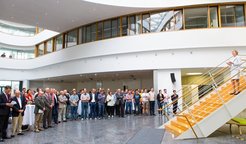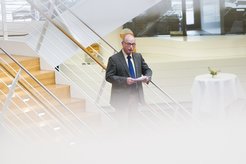Inauguration of the new CFEL building
Cooperation of DESY, University of Hamburg and Max Planck Society underlines Hamburgs top-ranking position as an international center for structural research
Today, on June 17, 2013, the new research building of the Center for Free-Electron Laser Science (CFEL) was inaugurated at the Campus Bahrenfeld. CFEL is a cooperation of DESY, the University of Hamburg and the Max Planck Society. In CFEL, the partners pool their university and non-university expertise to investigate structural changes, e.g. of atoms, molecules and condensed matter.

The Free and Hanseatic City of Hamburg and the Federal Republic of Germany realised a research building designed by the hammeskrause architects and located in the north east of the DESY campus. The building will meet the requirements of biology, biological chemistry, chemistry and physics. It has an interior area with daylight coming through futuristic cupolas, wave-like wall elements, variable offices and enough space for communication – all this will further stimulate international top level research at CFEL. The costs of the building, including the extension of the central campus workshop, amounted to about 50 million euros. The federal government contributed 13.7 million euros as part of the research building funding initiative.

“With the investments in CFEL, the Hamburg Senate promotes its policy to further develop the leading position of Hamburg and the metropolitan region as an international centre of structural research. Thus I am very pleased that we are able to inaugurate today this unique centre of excellence in Europe for research with and at light sources of the next generation,” said science senator Dr. Dorothee Stapelfeldt. “The CFEL with its international brilliance will contribute to make the Hamburg research area even more attractive to scientists from all over the world. My thanks go to all partners who engaged in this project.”
“With its top class light sources FLASH and PETRA III, already today DESY offers unique possibilities to investigate the nanocosm. The new free-electron lasers as FLASH, or the European X-ray laser European XFEL which we are currently building with 11 international partners, will enable so far unparalleled insights into new materials, pathogens, biomolecules and chemical reactions,” said Prof. Dr. Helmut Dosch, chairman of the DESY Board of Directors. “DESY is a pioneer in this technology and, with the Center for Free-Electron Laser Science, we and the University of Hamburg and the Max Planck Society successfully implemented our initiative to join the world’s elite of this research field on the campus in Bahrenfeld.”
“The CFEL offers scientists the possibility to work in interdisciplinary teams and achieve outstanding research results which later on will find application in the development of new medication or as basic knowledge for IT and electrical engineering. As a partner, the university will contribute its physics research fields, e.g. detector development, laser physics, physics of ultra-short X-ray pulses and X-ray spectroscopy and dynamics,” said Prof. Dr. Dieter Lenzen, President of the University of Hamburg. “My thanks go to all those who jointly contributed to create this project. CFEL became a unique networking centre and a nucleus of top level research in the sector of dynamic processes in all fields of matter.”

“Photon sources as PETRA III, or free-electron lasers which already exist or are built in Hamburg, allow deep insights into the microcosm of cells, molecules and even interstellar clouds, and help to unveil their structural mysteries,” said Prof. Dr. Martin Stratmann, vice president of the Max Planch Society. “For this aim, the Center for Free Electron Laser Science bundles the forces of three outstanding partners: the University of Hamburg, the Helmholtz research centre DESY and the Max Planck Society. Only in such a long-term cooperation it is possible to realise internationally pioneering large-scale projects like the European XFEL. This new building, which will host scientists from all three institutions, will facilitate and intensify this cooperation.”
Background CFEL
CFEL is a cooperation of DESY, the University of Hamburg and the Max Planck Society. It was established to fully exploit the interdisciplinary possibilities offered by DESY’s radiation sources of the newest generation: PETRA III, FLASH and, in future, the European XFEL. In CFEL, the three partners combine a unique strategy in Europe: experts of many research disciplines work with different research tools to observe ultra-fast nano processes from different points of view. They use extremely short X-ray flashes from X-ray lasers, optical lasers, or the most modern electron and scanning tunnelling microscopes. At the same time, scientists actively develop their research tools and make fundamental contributions to further investigate the dynamic processes in all fields of matter. With extremely intensive X-ray flashes, CFEL scientists irradiate cells, viruses, proteins and nanoparticles to decode their structure and develop new basic knowledge for the design of new medication. They investigate ultra-fast processes in solids and use it as fundamentals for information technology and power engineering. With “molecular movies”, they make visible the process of chemical reactions and the interaction of individual reactants.


